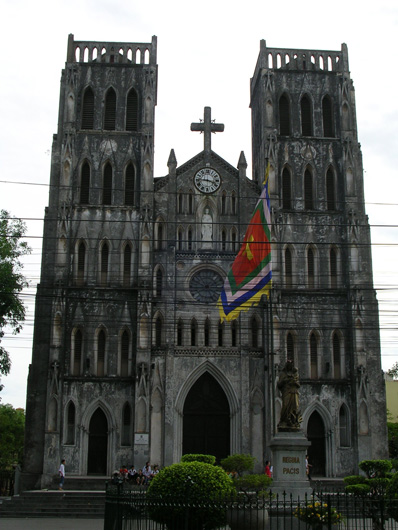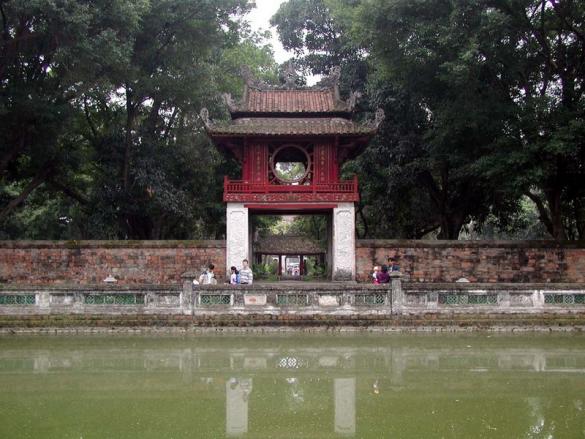Pulling into Hanoi in the early hours of the morning on the night train from Hue, the streets were already busy. As the train rattled its way slowly through the city’s outlying suburbs, people everywhere seemed to be engaged in various forms of exercise: some walking in large groups that moved with an almost military precision, others practising what looked like a form of Tai Chi, still others filling every spare piece of pavement, playing badminton on makeshift courts marked out on the streets. It seemed that there was no place for laziness in the Vietnamese capital.
It has been said that visiting Hanoi is like stepping back in time, which is still true, although things are changing fast. As well as its Confucian-era roots, the city preserves perhaps more than anywhere else in Vietnam something of a colonial atmosphere. It is a matter of conjecture as to just what is the city’s biggest inheritance from the French, who seized Hanoi in 1872: a café culture, fresh baguettes and a noticeably higher percentage of people who speak French rather than English as a second language, or a grandiose public architecture and its accompanying broad, tree-lined avenues.


Certainly there are more than a few ghostly traces of the French presence scattered throughout the city’s old quarter: an arch here, a rooftop there, rows of now-crowded balconies, all of which prove more intriguing than the colonial power’s former administrative buildings, now being used as, well, administrative buildings. St Joseph Cathedral in contrast, built at the end of the nineteenth century, seems surprisingly ugly and dull, ultimately out of place amongst its colourful surroundings. It stands like a silent reproach to its own nearby Buddhist flag, which has been suitably modified by the presence of a gold cross.
Despite these remains of a Western presence, one is sooner or later very aware of being a foreigner in a country that has spent much of its recent history seeing off foreign invaders. Ironically, this may have something to do with the more obvious signs of the country’s communist regime, itself a foreign import: the large statue of Lenin proudly erected in a square across from the Army Museum, the ever-present uniformed guards outside public buildings, who seem to guard against the taking of photography as much as anything else, the populist cult of Ho Chi Minh, and the ruling communist party’s large propaganda billboards.


Maybe precisely because of this feeling of being an outsider, it is in Hanoi that one can also begin to grasp the true scale of Vietnamese history, something that definitely didn’t just start with the country’s ill-fated involvement with the West. The Temple of Literature, today more than ever an island of serenity amidst the surrounding chaos, was founded in 1070, and as the site of the country’s first university predates almost all of those in Europe. Meanwhile, the old quarter of the city has a history at least as long as many of its European contemporaries.
Walking the city’s crowded streets one often comes close to sensory overload. The noise is constant, mostly due to the unbelievably mad bustle of traffic: motorbikes, bicycles and cyclos, all frequently loaded beyond rational explanation, all beeping horns or ringing bells with abandon, apparently in some sort of coded communication with the flow of vehicles around them. Being a pedestrian amongst this can be a genuinely hazardous business. With a complete absence of pedestrian crossings the only chance of crossing the road is to edge out into the confusion slowly, trusting that the traffic will move around you, something that initially feels like a death wish, but move it invariably does.
With people spending a good part of their day outdoors, there is also the constant sight, and smell, of roadside food stops; locals crouched down on the seemingly ubiquitous small, plastic stools (one model, three colours), intent on devouring the particular mixture of noodles, vegetables and meat on offer. To wash it down there are the rightly renowned "Bia Hoi" halls; makeshift joints jammed into alleyways or courtyards, serving cold beer straight from the keg at dangerously low prices, floors littered with small, thin napkins and empty peanut shells.
The capital city of a land full of contradictions, the present and past often exist in Hanoi, sometimes incongruously side-by-side, surely a result of the often breakneck pace at which parts of the country continue to move. The motorway out to the airport, which runs north from the city over the Red River, lay swathed in smoke from people burning off material on the rice paddies that stretch into the distance on either side. The road itself, like a metaphor for the country’s present condition, consisted of two lanes for motorbikes, cars and trucks, and another for bicycles and horse-drawn carts. Where that road leads for Vietnam one can only wait and see.